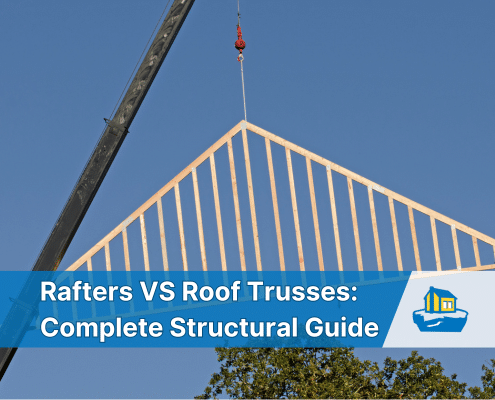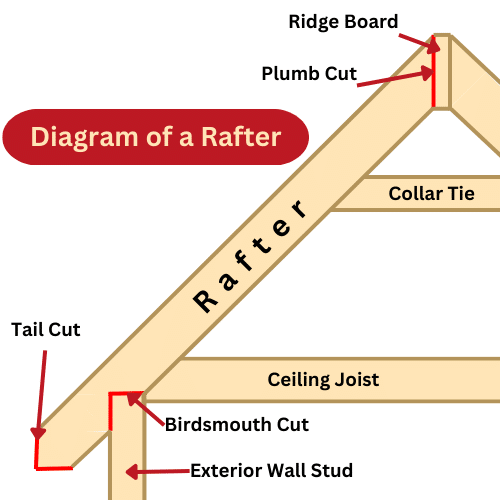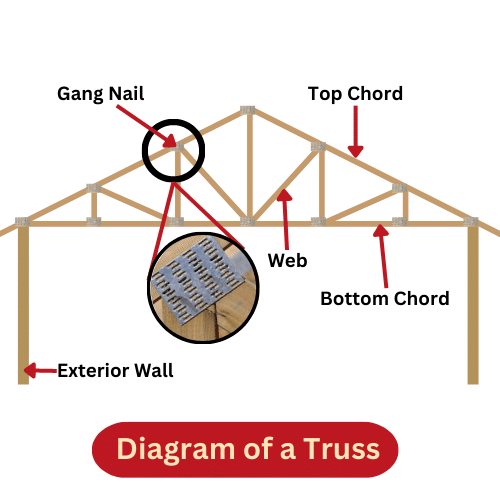4.8 1700+ Google Reviews

When it comes to your roof/attic structure, there are two primary construction types: rafters and roof trusses. Knowing the difference between rafters and trusses helps you choose between the two when building a new home, communicate better with contractors, and know whether or not you need an engineer for modifications.
Basically, it’s just one of those things you need to know as a homeowner.
In construction, “stick-built” or stick framing refers to the traditional method of building a house by assembling it’s framing on-site using individual pieces of lumber. To clarify, rafters refer to stick-built construction, while trusses do not.
In roofing, the ridge refers to the top of the roof or the peak.
A ridge board is a non-structural board between the peak of two rafters. In particular, it provides a nailing surface for the rafters.
An eave is the part of a roof that overhangs the outside walls of a building. Functionally, an eave is an important component of the roof system as it helps to protect the walls from rainwater by directing it away from the building. Plus, the eaves support the gutter attachment.
Dimensional lumber is a generic term that refers to industry-standard lumber used in construction. For example, 2×4, 2×8, and 4×4 are all typical dimensional lumber sizes used in a wooden structure.
Studs are the vertical members of a wall. They are typically made from 2×4 or 2×6 lumber. (Think stud finder)
Primarily, roof rafters are structural components that support the roof deck and the weight of the roof itself. In addition, rafters support additional loads such as snow and people. Rafters are typically long, angled wood beams that run from the peak of the roof (the ridge) down to the eaves. Framers make these beams from regular dimensional lumber cut to size at the job site.
They are usually spaced evenly across the roof (every 16 inches like studs), and the size and spacing of the rafters will depend on the design of the roof, the weight of the materials, and the local building codes and regulations.
Finally, framers the rafters to the ridge board at the top and to the exterior walls at the bottom.

A roof truss is a structural support engineered to support a roof. Simply put, it consists of interconnected triangles made of wood, steel, or other materials that distribute weight evenly across the entire roof structure. As a result, builders have the freedom to make longer spans than traditional rafters. Also, trusses are typically prefabricated off-site and then installed at the construction site.
Summing it up, trusses incorporate rafter boards, ceiling joists, and collar ties into one structural unit and eliminate the need for a ridge board.
Roof truss systems are a popular choice for building construction because they are strong, lightweight. Plus, framers can quickly and easily install them saving time and money during the construction process. They also provide a more open space in the attic or roof area than traditional rafters, which can be helpful for storage space or for creating living space.

Roof rafters have several advantages over roof trusses
Overall, roof rafters provide a practical, alterable, and aesthetically pleasing option for roof support in various building types and architectural styles.
While roof rafter construction has many advantages, there are some potential disadvantages to consider as well.
Overall, roof trusses shine where rafters fall short.
Roof trusses have several advantages over traditional roof framing methods like rafter construction.
While roof trusses have many advantages you should also consider their disadvantages.
It’s essential to consider both the pros and cons of using roof trusses when deciding on the best roofing system for a particular building project.
Both roof trusses and rafters support the roof and roof loads. However, there are some important differences between the two.
Rafters are easily cut on-site, are great for custom jobs, and offer more attic space. Plus, they’re easy to modify.
On the other hand, roof trusses are built off-site, requiring a lot of design and lead time for delivery. As a result, your construction project could get delayed while waiting for trusses. However, trusses span longer distances, reduce labor costs, and allow fewer internal load-bearing walls. In addition, unlike rafters, trusses require a structural engineer for modifications.
For the most part, trusses are the right option for most new home construction. However, sometimes rafters are the best option. Use rafters when you want to turn the attic into living space, on a small addition, or a specialty roof design.